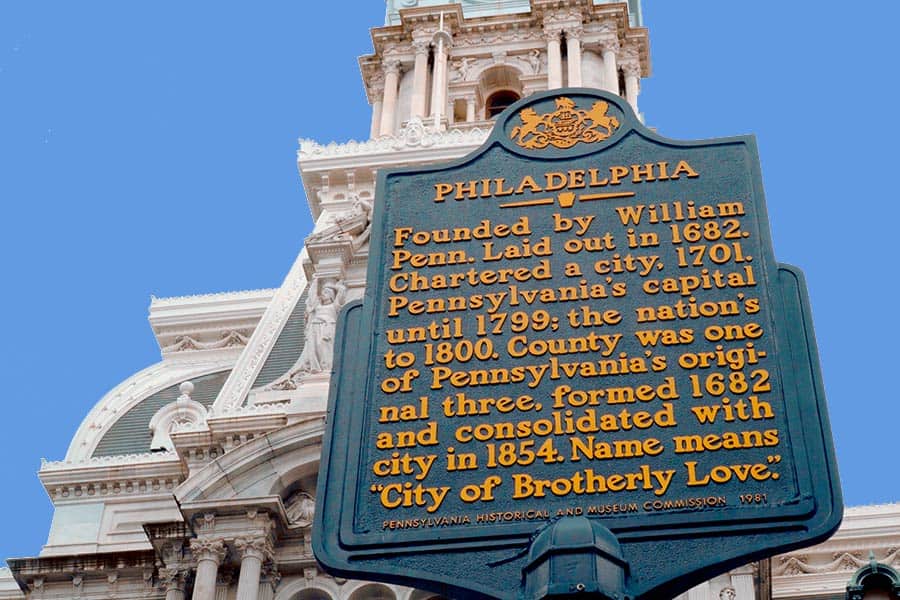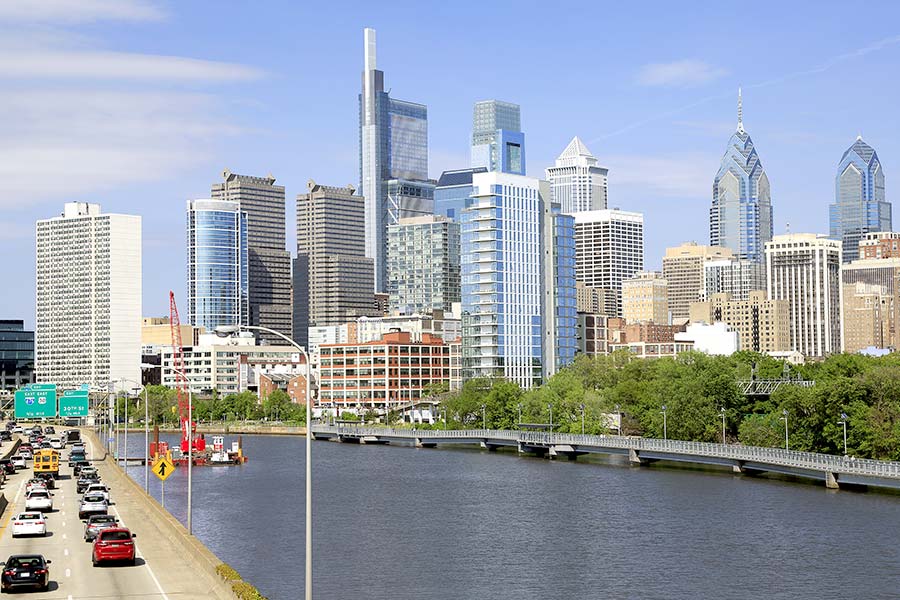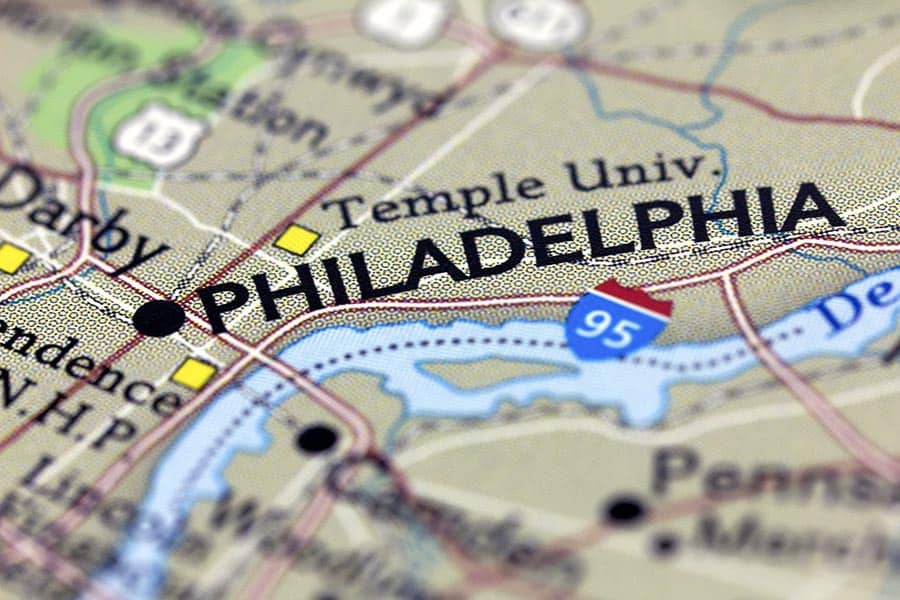
Philadelphia is one of America’s most interesting and historical cities, which makes it a very popular place to visit. But is it hard to drive in Philadelphia?
Philadelphia is a major city and can be challenging to drive in and through, especially during rush hour. In addition, Philadelphia is a congested city, and drivers there can be quite aggressive. However, cautious, attentive, and even-tempered drivers will be able to drive in Philadelphia.
So when is the best time to drive through Philadelphia? What time does rush hour start in Philadelphia? What major highways go around and through the city? Learn more about driving in Philly in the following sections.
Driving in the City of Brotherly Love
With nearly 6 million people living in the Philadelphia metro area, a busy airport, and a major seaport, the roads in Philadelphia can get pretty congested. And despite the city’s unofficial moniker as the City of Brotherly Love, drivers in Philadelphia are notoriously aggressive. As a result, Philadelphians tend to follow close and like to engage in brake checks with their fellow drivers.

The worst day of the week to drive in Philadelphia is probably Friday. Worn out from a long work week, commuters and locals alike flood in and out of the city to get a head start on their weekends, often facing the twin evils of fatigue and time pressure. Unfortunately, these factors often lead to bad driving practices. In fact, the phenomenon has earned its own name – Frustrated Friday!
These phenomena also coincide with Philadelphia’s weather. Summer rains, winter blizzards, fog, ice, and drizzle can add an interesting layer of chaos to the driving in Philadelphia. So be sure your vehicle is in good condition, with appropriate tires, good brakes, and functional lights.
Between aggression, weather, and congestion, Philadelphia does suffer a fair number of car accidents. It’s estimated there are about 30 crashes a day in Philadelphia, with about 13% leading to injury and 9% leading to death. Bikers and pedestrians should be extra cautious; they are frequent victims of inattentive drivers.
Philadelphia has a few specific traffic rules you should know about:
- Philadelphia is hands-free. You may not handle your cell phone while driving in the city.
- Drivers must slow down and, if possible, move over for construction zones, workers, vehicles, and equipment.
- You may not take photos of emergency personnel such as firefighters or paramedics.
It might sound like Philadelphia is a hassle, but don’t give up now: it’s not all bad news. Thanks to the genius of William Penn, Philadelphia was the first city in the United States to have its streets arranged in a logical grid extending from a central point, making Philadelphia relatively easy to navigate.
Philadelphia also has good transit and is very walkable, so driving is not a necessity in the city.
Keystone Answers Fun Fact: The term “turnpike” dates back centuries. Bandits, brigands, and local governments used wooden pikes mounted to turnstiles to stop and extract tolls from foot and horse traffic. Then, they would turn the pike to open or close the road, which led to the development of the word “turnpike.”
What Time Does Rush Hour Start in Philadelphia?
Rush hour in Philadelphia begins as early as 6:00 AM. Because the area around Philadelphia is densely populated with commuters, and because the topography of the area makes it difficult to add or expand existing road networks, the roads become congested rather early in Philadelphia.
While it begins early, rush hour in Philadelphia finishes late. So if you’re driving in Philadelphia, expect the traffic to be very heavy until almost 10:00 AM.

After the morning rush, traffic dies down to a more reasonable level for a few hours while the working people of Philadelphia perform their various jobs. Then, finally, offices begin to clear out around 3:00 PM, and the roads become flooded with traffic again until about 7:00 PM.
On the weekends, the traffic flow in Philadelphia is almost inverted. So if you want to visit the city on the weekend, get on the highway before 8 AM. Commuters and tourists usually sleep in on the weekends, so take advantage of the quiet early hours to get into the city before traffic stacks up.
What’s the Best Time to Drive Through Philadelphia
With more than 5.7 million people living in metro Philadelphia, this bustling city is almost always busy. If you are trying to time a drive through Philly, the best period of time is between 10 AM and 2 PM. These hours sit between the major rush times and are generally the easiest hours to pass through the city.
Pro Tip: Locals recommend tuning your radio to 1060 AM as you approach the city to get the most up-to-date traffic information. It’s also a good idea to familiarize yourself with the roads around the city before you travel to Philadelphia.

What Major Highways Run Through and Around Philadelphia?
The main arterials feeding Philadelphia are I-95, I-76 (also known as the Schuylkill Expressway,) I-676, and I-276, also known as the Pennsylvania Turnpike.
I-95 travels the length of the city from Philadelphia International to the Croydon area near the border with New Jersey. I-95 has between six and eight lanes of traffic and can be quite congested at times. In addition, it is a major thoroughfare connecting most major cities along the Eastern Seaboard, making it a very busy road at times.
I-76, also known as the Schuylkill Expressway, flows along the west bank of the Schuylkill River. It is generally six lanes in width with occasional variations. I-76 is home to the notorious Conshohocken Curve, which is a common site for accidents and serious congestion. This curve, located just northwest of the city, contributes to backflow all the way into the city, especially in the event of bad accidents. Use caution on I-76.
Passing through the city center near Logan Square and Franklin Town, I-676 is a four-to-six lane expressway that flows in and out of Philadelphia. 676 crosses both the Schuylkill and Delaware Rivers and flows all the way into New Jersey. 676 also has two interchanges with I-95.
The Pennsylvania Turnpike, also known as I-276, sits just north of Philadelphia’s urban core and runs roughly east-west. Popular with commuters, I-276 connects with 476 (locally known as the Blue Route, 476 is an extension of the Turnpike that connects the suburbs to the city) and I-76 near Valley Forge. As a result, this route can be pretty busy during rush hour.
Is There a Bypass Route Around Philadelphia?
If you’re driving near Philadelphia but want to bypass the city, your best bet is route 295. I-95 passes directly through the heart of the town, which can make for a rather exciting driving experience if you’re not prepared. I-295 splits off 95 near Wilmington, Delaware, and connects back to 95 in the area near Florence, New Jersey, completely avoiding Philadelphia. That said, 295 can still be quite congested as it passes through some densely populated parts of New Jersey.

I-76 also passes directly through Philadelphia. Originating in Bellmawr, New Jersey, 76 passes through south Philadelphia before continuing west toward Ohio. Your best bet to avoid the city is to take 676 around the urban core; that said, you should still expect heavy traffic on 676.
If you’re north of the city, I-276 is a convenient east-west bypass but can still be quite busy during rush hour as it connects the suburbs to the city.
Is Parking Hard to Find in Philadelphia?
Philadelphia has a lot of parking, but there are also a lot of people in the city. The Philadelphia Parking Authority operates several garages and lots in the city, and there are thousands of metered spots throughout the city for short-term parking. If you do park on the street, read the parking signs carefully. In addition, many neighborhood spots are limited to short-term parking and have time or date-sensitive restrictions to facilitate things like plowing or street sweeping.
Philadelphia parking rates vary, but you should expect to pay at least $2 per hour to park. If you are visiting the city, you may find it easier to use local transit options or walk – Philadelphia is a very walkable city.
If you need to find a parking spot, your best bet is to check the Philadelphia Parking Authority’s website. The PPA keeps its website up-to-date with current information about parking closures and provides a plethora of other helpful information.
Driving in Philadelphia: Busy, But Achievable
Philadelphia is one of the most important cities in the United States. Millions of people flock to the city every year to visit historical sites, engage the tourist economy, and experience this wonderful and unique American place for themselves.
While driving in Philadelphia can be challenging, it’s achievable for any reasonably cautious driver who pays good attention to the road. If you prefer not to drive, Philadelphia does have a very robust transit system and is a very walkable place. However you choose to get around, make sure you come and see everything the City of Brotherly Love has to offer.






